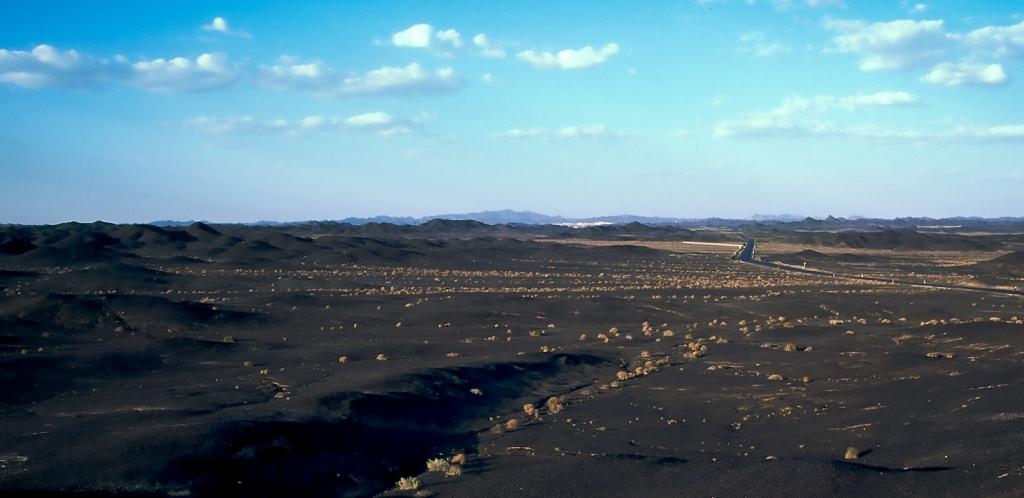~ China: Travel Survival Kit
Lonely Planet Publications, 1996 edition
Camera in hand, I walked up a hillside loosely but wholly encrusted with sharp black stones, skittling and crunching underfoot. Atop it, a computer-generated landscape of mathematical curves, complex and perfect, inorganic yet alive. Stone and air, earth and water, erosion and time. The sun expels its last breath, igniting the haze clinging in the hollows of the low bare hills which rise to small peaks in the distance. The smoothness of hillsides in curving interplay disguises the rough, unfriendly surface I kick up. A caption comes to mind: “Artist’s Concept,” as accompanies images of other fantastic, otherworldly landscapes.
Behind me, the roadway rounds an outcropping of hills, black as the thin scattering rock it slides through. White meter markers line its path, upright and brilliant in the sun’s final rays. I know where it leads, Liuyuan. There, in the distance. Not nestled, too comfortable an image. No. Dug in. And yet, comfortably so. A city in the distance. I make out black portal windows in a wide expanse of sun-warmed white tile like aged ivory. Again, sunlight plays its magic late illumination. In the ebony hills, an ivory city. Liuyuan.
First impressions.
Memories recorded on film, I scramble back down the hillside and cycle between the radiant white markers until the sun slips below the ebony escarpment to the west. The final five kilometers mimic the terrain we have doggedly pedaled all afternoon, a climb just steep enough to be arduous. Tired long ago. Soon the reserve tank. Through the barren industrial yards. 8PM, everyone at home. The edge of town, half-lived-in, half-worked-in, half in ruins. Forlorn-looking, yes. I see through crumbling walls, and smell the grease and oil and uncatalogueable grime staining the roadway. Dismal even. Like the black, coarse stone encrusting the graceful hills? Children, ragamuffins, play in the side-streets. But still two kilometers to ‘town’.
Gradually, perceptibly, a town emerges. White tile hotels and banks, white-wash apartment blocks; a little worn, a little coarse. Not the ivory promised by the setting sun, and the treeless streets feel barren in comparison to the oasis towns I’ve grown accustomed to. But I think there is not here an encrusting of jagged black rock, not a town without horses, or at least, not a one-horse town without a single horse.
When I stop in front of a white-tiled hotel, to wait for Emma and suss out the guidebooks, I draw the same kind of curious crowd of Chinese I always draw. They seem not so in need of cheering up. Among the crowd is a vision in white cotton. An ankle length skirt and a frilled, feminine blouse drawn tight to her narrow waist. Raven hair. Ebony flows down and over an ivory shoulder. A friend stands behind her, shouts, “Hello,” then ducks, leaving the vision to face my searching eyes. Giggles from the concealed. Ebony, ivory and a red-rose blush from the vision, who cannot, quite, turn from my gaze.
No, no cheering up required here.
We spend the night there, and the next day. Some nice meals. Some pleasant people, curious, engaging. Some compliment my ridiculously limited chinese. On a late-afternoon walk I discover the tree-lined avenue, notice for the first time the newness of the train station. Above its main hall I discover a marvellous mural of Apsaras — Buddhist wingless angels you’ll find painted in the cave grotto murals all along the Silk Road. I find the town park with its neat rows of willow and poplar, concrete walkways and planters, exuberant purple flowers. Yes, the fountains are disused, carnival rides rusted to a standstill, but rising above these are three small hills, stone encrusted, at the top of two are gazebos and on the third a pagoda.
I climb the tallest and am again in the valley of the gentle hills with ragged skin. I am on an ebony hill in an ivory town. The sun slides well past zenith, creeps under gazebo eaves, and a wind kicks up out of the north west. Trains arrive from the east, with passengers or cargo or carloads of minerals. Below me, in the park, children on their way home from school run back and forth across a suspension bridge, delighting in the clangy racket as the metal runway clatters and clanks underfoot.
This is no tourist destination. It is a small, busy, virile town of subtle charm like so many other small, busy, virile towns. You will never discover the charms if you arrive on the train and depart on the next bus.
The best discoveries on any journey aren’t found in a book.
Gansu Province, China
Taken during travels, 1998
